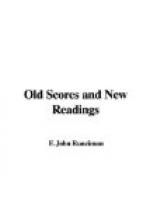The pervading note of the whole work is struck at the beginning of the first number. Had Mozart seen death as Handel and Bach saw it, as the only beautiful completion of life, or even as the last opportunity given to men to meet a tremendous reality and not be found wanting, he might have written a sweetly breathed prayer for eternal rest, like the final chorus of the “Matthew” Passion, or given us something equal or almost equal to the austere grandeur of the Dead March in Saul. But he saw death differently, and in the opening bar of the “Requiem aeternam” we have only sullen gloom and foreboding, deadly fear begotten of actual foreknowledge of things to come. The discord at the fifth bar seems to have given him the relief gained by cutting oneself when in severe pain; and how intense Mozart’s pain was may be estimated by the vigour of the reaction when the reaction comes; for though the “Te decet hymnus” is like a gleam of sweet sunshine on black waters, the melody is immediately snatched up, as it were, and, by the furious energy of the accompaniment, powerful harmonic progressions, and movement of the inner parts (note the tenor ascending to the high G on “orationem"), made expressive of abnormal glowing ecstasy. To know Mozart’s mood when he wrote the Requiem is to have the key to the “Kyrie.” His artistic sense compelled him to veil the acuteness of his agony in the strict form of a regular fugue; but here, as everywhere else in the Requiem, feeling triumphs over the artistic sense; and by a chromatic change, of which none but a Mozart or a Bach would have dreamed, the inexpressive formality of the counter-subject is altered into a passionate appeal for mercy. In no other work of Mozart known to me does he ever become hysterical, and in the Requiem only once, towards the end of this number, where the sopranos are whirled up to the high A, and tenors and altos strengthen the rhythm; and even here the pause, followed by that scholastic cadence, affords a sense of recovered balance, though we should observe that the raucous final chord with the third omitted is in keeping with the colour of the whole number, and not dragged in as a mere display of pedantic knowledge. The “Dies Irae” is magnificent music, but the effect is enormously intensified by Mozart first (in the “Kyrie”) making us guess at the picture by the agitation of mind into which it throws him, and then suddenly opening the curtain and letting us view for ourselves the lurid splendours; and surely no more awful picture of the Judgment was ever painted than we have here in the “Dies Irae,” “Tuba minim,” “Rex tremendae,” and the “Confutatis.” The method of showing the obverse of the medal first, and then astonishing us with the sudden magnificence of the other side, is an old one, and was an old one even in Mozart’s time, but he uses it with supreme mastery, and results that have never been equalled. The most astonishing part of the “Confutatis” is the prayer at the finish, where strange cadence




